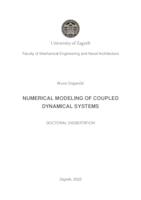Pages
-

-
Numerical modeling of coupled dynamical systems
-
Bruno Dogančić This dissertation focuses on uncertainty modeling, robust stability, and performance
analysis of coupled multi-input multi-output (MIMO) reduced-order dissipative dynamical
systems. Large-scale structural dynamics systems, micro-electro-mechanical
systems (MEMS), flexible multi-body dynamics systems (FMBDS), and similar systems
are examples of such systems. For modeling and analyzing such systems, spatial
discretization techniques (SDMs) such as the finite element method (FEM) are...
-

-
Numerical modeling of damage in heterogeneous materials using strain gradient theory
-
Filip Putar Prevention of the damage phenomenon in the structural components has always been a major criterion for keeping the longest possible working lifetime of the engineering systems and thus the minimization of the financial expenses due to maintenance, as well as for the safety of the people who benefit from such systems. In recent times, the need for keeping the track of the damage is even higher as a demand towards lighter, thinner and smaller designing solutions is rapidly increasing, where...
-

-
Numerical modelling of autoignition chemistry kinetics in computational fluid dynamics
-
Marko Ban The research in this work aims at improving application of the simulation of fuel ignition, focusing on the low-temperature auto-ignition phenomenon. The simulation of low temperature ignition has been typically achieved by using computationally demanding calculations of complex chemistry kinetics. This work attempts to reproduce the effects of complex chemistry by developing the methodology of efficient database creation consisting of the relevant ignition data used by existing combustion...
-

-
Numerical modelling of coupled potential and viscous flow for marine applications
-
Vuko Vukčević A numerical framework for coupling arbitrary potential flow with fully nonlinear, two-phase and turbulent Computational Fluid Dynamics model is presented in this work. The model is implemented in arbitrary polyhedral Finite Volume method in OpenFOAM software. The present model relies on the Ghost Fluid Method for discretisation of jump conditions, yielding infinitesimally sharp density and pressure jumps across the free surface. Interface capturing is achieved with implicitly redistanced...
-

-
Numerical modelling of intrinsic self-healing in fibre reinforced composite structures
-
Dominik Brezetić This research is focused on development and validation of efficient numerical methodology for modelling of intrinsically self-healing fibre reinforced composite structures. A multiscale approach is used which enables modelling of each constituent and its features at the microscale. For that purpose, the Rule Of Mixtures (ROM) has been employed for
the homogenisation, whereas the Voigt (iso-strain) and Reuss (iso-stress) approximations
have been used as a means for localisation. The...
-

-
Numerical modelling of multi-component dense sprays
-
Robert Keser Current challenges in the development of non-premixed combustion devices are often correlated with the capability to accurately predict the dynamic behaviour of liquid sprays, which have a complex chemical composition and are subjected to a broad range of operating conditions. Even though fuel spray modelling is not a new or unknown problem, constant innovations in efficiency advancements and new fuels require new modelling solutions with enhanced capability and accuracy.
This study...
-

-
Numerical modelling of multiphase flow in combustion of liquid fuel
-
Milan Vujanović The focus of this work is on an integrated simulation approach, which can be applied in numerical simulations of turbulent multiphase droplet flow in practical combustion systems, adopting methods for simulation of dense and dispersed spray in conjunction with combustion and nitrogen emission formation. The first objective was to establish the validated Eulerian multiphase spray modelling approach, which can be applied with confidence in high pressure diesel spray simulations, particularly...
-

-
Numerical modelling of pollutant formation and removal during fuel combustion
-
Tibor Bešenić Reduction of harmful impact on the environment caused by rapid development of a fossil
fuel-powered society is one of the most significant global challenges. The combustion-related
pollutants such as sulfur oxides and nitrogen oxides stand among the most harmful ones due to
large amounts of emissions discharged globally. The advanced models that provide insight into
pollutant production and removal processes can be useful in designing new, more sustainable
technology. Numerical...
-

-
Numerical modelling of radiative heat transfer and tabulated chemical kinetics in multiphase reactive processes
-
Filip Jurić Radiative heat transfer plays a significant role in total heat transfer in industrial systems
that operate at high temperatures. Therefore, this research aims to develop and implement a
new model for calculating the radiative absorption coefficient that considers the radiative
spectral properties of the medium. The discrete ordinates model for control volumes will be
applied to solve the radiative transfer equation. The proposed model will be validated using
analytical results...
-

-
Numerical modelling of spray and combustion processes using the Euler Eulerian multiphase approach
-
Zvonimir Petranović The goal of this thesis is to develop advanced engineering method for numerical modelling of highly turbulent multiphase combustion processes. The first objective was to use the commercial 3D Computational Fluid Dynamics (CFD) code FIRE® and model real engineering system by changing various combustion parameters. In this section, the spray process was modelled by employing the widely used Euler Lagrangian discrete Droplet Method (DDM). The focus was to gain insight into advantages and...
Pages

